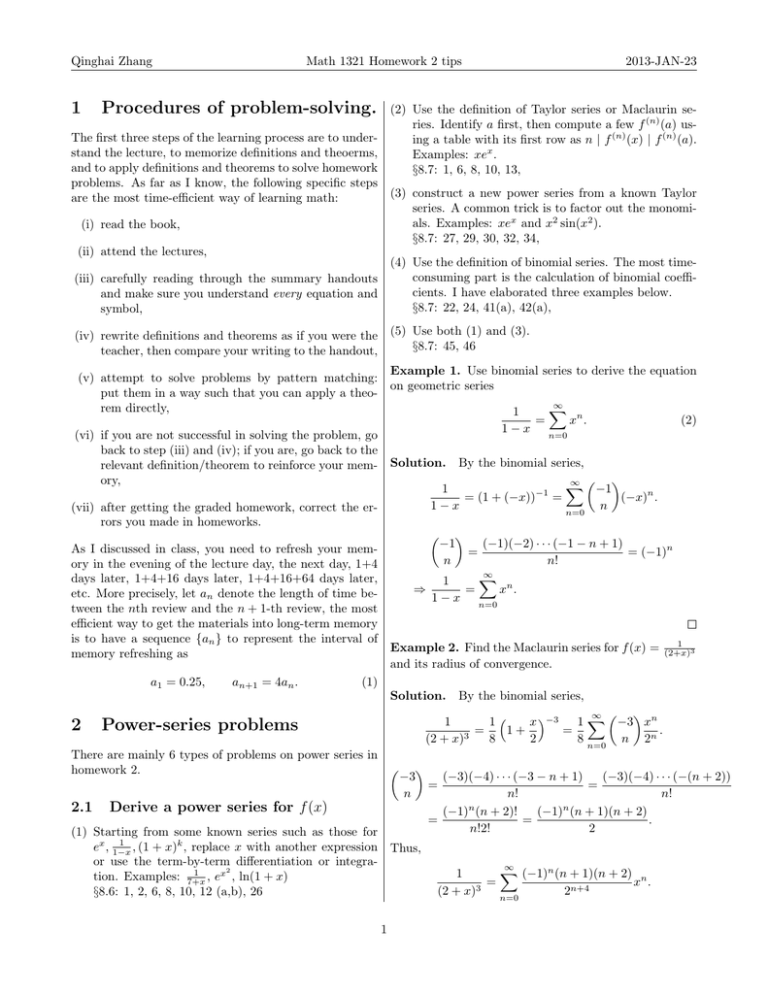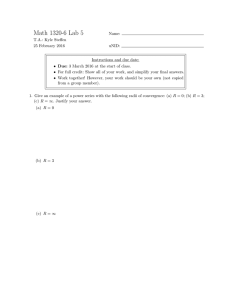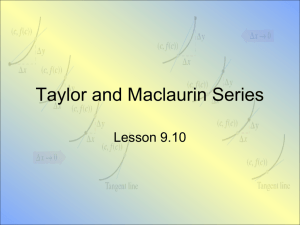1 Procedures of problem-solving.
advertisement

Qinghai Zhang
1
Math 1321 Homework 2 tips
Procedures of problem-solving.
2013-JAN-23
(2) Use the definition of Taylor series or Maclaurin series. Identify a first, then compute a few f (n) (a) using a table with its first row as n | f (n) (x) | f (n) (a).
Examples: xex .
§8.7: 1, 6, 8, 10, 13,
The first three steps of the learning process are to understand the lecture, to memorize definitions and theoerms,
and to apply definitions and theorems to solve homework
problems. As far as I know, the following specific steps
are the most time-efficient way of learning math:
(3) construct a new power series from a known Taylor
series. A common trick is to factor out the monomials. Examples: xex and x2 sin(x2 ).
§8.7: 27, 29, 30, 32, 34,
(i) read the book,
(ii) attend the lectures,
(4) Use the definition of binomial series. The most timeconsuming part is the calculation of binomial coefficients. I have elaborated three examples below.
§8.7: 22, 24, 41(a), 42(a),
(iii) carefully reading through the summary handouts
and make sure you understand every equation and
symbol,
(iv) rewrite definitions and theorems as if you were the (5) Use both (1) and (3).
§8.7: 45, 46
teacher, then compare your writing to the handout,
Example 1. Use binomial series to derive the equation
(v) attempt to solve problems by pattern matching:
on geometric series
put them in a way such that you can apply a theo∞
rem directly,
X
1
xn .
(2)
=
1 − x n=0
(vi) if you are not successful in solving the problem, go
back to step (iii) and (iv); if you are, go back to the
relevant definition/theorem to reinforce your mem- Solution. By the binomial series,
ory,
∞ X
1
−1
= (1 + (−x))−1 =
(−x)n .
1−x
n
(vii) after getting the graded homework, correct the ern=0
rors you made in homeworks.
−1
(−1)(−2) · · · (−1 − n + 1)
As I discussed in class, you need to refresh your mem= (−1)n
=
n!
n
ory in the evening of the lecture day, the next day, 1+4
∞
X
days later, 1+4+16 days later, 1+4+16+64 days later,
1
xn .
=
⇒
etc. More precisely, let an denote the length of time be1 − x n=0
tween the nth review and the n + 1-th review, the most
efficient way to get the materials into long-term memory
is to have a sequence {an } to represent the interval of
1
Example 2. Find the Maclaurin series for f (x) = (2+x)
3
memory refreshing as
and its radius of convergence.
a1 = 0.25,
an+1 = 4an .
(1)
Solution. By the binomial series,
∞ 1
1
x −3
1 X −3 xn
2 Power-series problems
=
1+
=
.
(2 + x)3
8
2
8 n=0 n 2n
There are mainly 6 types of problems on power series in
homework 2.
−3
(−3)(−4) · · · (−3 − n + 1)
(−3)(−4) · · · (−(n + 2))
=
=
n
n!
n!
n
n
2.1 Derive a power series for f (x)
(−1) (n + 2)!
(−1) (n + 1)(n + 2)
=
=
.
n!2!
2
(1) Starting from some known series such as those for
1
, (1 + x)k , replace x with another expression Thus,
ex , 1−x
or use the term-by-term differentiation or integra∞
2
X
1
1
(−1)n (n + 1)(n + 2) n
tion. Examples: 7+x
, ex , ln(1 + x)
=
x .
3
(2 + x)
2n+4
§8.6: 1, 2, 6, 8, 10, 12 (a,b), 26
n=0
1
Qinghai Zhang
Math 1321 Homework 2 tips
By the convergence theorem of the binomial series, x2 <
1, hence R = 2.
2013-JAN-23
§8.7: 59, 60, 62, 64, 66
1
Example 3. Find the Maclaurin series for f (x) = √4−x
2.4 Approximate f (x) with power series
and its radius of convergence (compare
to
page
612
on
Q
the text to see how the usage of
enables you to write In most cases you can keep calculating the terms until
you hit the term whose absolute value is less than the
less).
accuracy threshold.
§8.6: 28, 31;
Solution. By the binomial series,
§8.7: 40, 41(b), 42(b), 48
n
∞ 1
x − 12
1
x
1 X − 12
However, you need to be confident with the accuracy
√
=
1−
.
=
by applying the remainder theorems. Read the example
2
4
2 n=0 n (−4)n
4−x
on the homework handout.
Q
1
n−1
(− 21 − i)
(− 12 )(− 21 − 1) · · · (− 12 − n + 1)
−2
= i=0
=
2.5 Find the interval of convergence
n!
n!
n
Qn
(2i − 1)
1 · 3 · 5 · · · (2n − 1)
For power series, use ratio test for the radius of conver=
= i=1 n
.
(−2)n n!
(−2) n!
gence and use some other tests for the two end points.
§8.5: 3, 8, 13, 18, 19, 23, 24, 27;
Thus
∞ Qn
1 X i=1 (2i − 1) xn
1
§8.6: 37.
√
= +
.
3n+1
2
2
n!
4−x
n=1
By the convergence theorem of the binomial series, x4 < 2.6 Prove convergence of a power series
1, hence R = 4.
Use the Taylor inequality. Understanding the proof from
Taylor theorem will be helpful. Read the example of
2.2 Derive a power series for a number sin(x) on (−∞, +∞) in the homework handout. Another
you will come across in the lab is to approximate
This is a specialized problem of the first type. The series example
x
e
at
0
with
a Taylor polynomial on (0, 1) similar to the
representing transcendental numbers such as π, e can be
following
derived by assigning special values to x.
∞
X
x2
xn
§8.6: 12(c), 39, 40
= 1 + x + ey ,
(3)
ex =
n!
2
n=0
2.3
Find the sum of a power series
where y ∈ (0, 1). The Taylor inequality does not apply
This is the converse of the first type and requires to (1 + x)k , why? Note that the Taylor theorem still
you to be familiar with the power series. Examples: applies.
P∞
n x5n
§8.7: 19
n=0 (−1) n!
2



